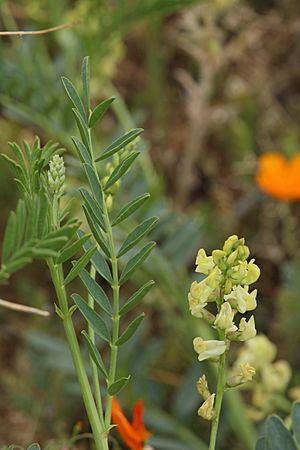Douglas's milkvetch facts for kids
Quick facts for kids Douglas's milkvetch |
|
|---|---|
 |
|
| Scientific classification |
Astragalus douglasii, also known as Douglas's milkvetch, is a type of milkvetch plant. It grows naturally in California and Baja California, Mexico. You can find it in many different places. These include deserts, valleys, chaparral, and mountain areas. It usually grows below 8,000 feet (2,438 meters) in elevation.
What it Looks Like
Douglas's milkvetch is a bushy plant that lives for many years. It has several stems that can stand up or lie on the ground. These stems can grow up to one meter (about 3 feet) long. The plant has many leaves, each up to 18 centimeters (about 7 inches) long. Each leaf is made up of several small, oval-shaped leaflets.
The plant produces many flowers in a group called an inflorescence. Up to 30 flowers can be in one group. Each flower is about one centimeter long and is whitish to pale yellow. The green part that holds the flower, called the calyx, has small lobes.
After the flowers, the plant grows a fruit. This fruit is a puffy pod, like a balloon. It can be up to 6 centimeters (about 2.4 inches) long and 3 centimeters (about 1.2 inches) wide. When the pod dries, it becomes thin and feels like paper.
Different Types
There are three main types, or varieties, of Douglas's milkvetch:
- A. d. var. douglasii: This type is only found in California.
- A. d. var. parishii (Parish's milkvetch): This type grows throughout the mountain ranges of Southern California.
- A. d. var. perstrictus (Jacumba milkvetch): This type is quite rare. It is found only in San Diego County, California, and northern Baja California.
See also
 In Spanish: Astragalus douglasii para niños
In Spanish: Astragalus douglasii para niños

